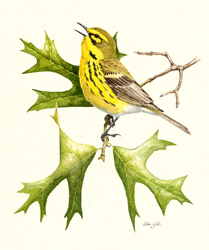Breeding Bird Atlases (BBA)
Find a Bird - BBA1
Breeding Bird Atlas 1 Species Accounts
Prairie Warbler
Dendroica discolor
Egg Dates
May 22 to June 21
Number of Broods
one; possibly two; will renest if first attempt fails

A species that prefers disturbed areas, the Prairie Warbler has probably expanded its range since the 1600s. In Massachusetts, settler-related activities and subsequent land use patterns, which persisted well into the twentieth century, greatly increased its favored shrubby habitats. The present status is uncertain, but populations may be declining as the forests of Massachusetts mature and suburban sprawl engulfs breeding habitat. This tendency was first noted on Cape Cod and is clearly accelerating in the pine barrens of Plymouth County today. Future changes in the distribution and abundance of Prairie Warblers in the Commonwealth may well continue to reflect this balance of habitat creation and elimination by human activities both here and on the wintering grounds, where rapid human population growth has also resulted in widespread habitat destruction.
Typical Massachusetts habitats are scrub, open woodlands, burned or logged areas, overgrown fields, power-line corridors, thickets of young pines, and, above all, Pitch Pine-Scrub Oak barrens. The patchy distribution of confirmed breeding records on the map reflects the discontinuous nature of this range of temporary habitats. However, the species can be astonishingly abundant in such optimum habitat as the Myles Standish State Forest in Plymouth County. There, Manomet Center for Conservation Sciences staff has estimated a population of 5,000 to 10,000 pairs, with a maximum density of 112 pairs per 100 acres in areas burned ten to twenty years previously.
Breeding plumage is attained by a partial molt on the wintering grounds in February and March, and spring migrants arrive in Massachusetts from late April to the end of May. Although Prairie Warblers are regularly observed during spring migration, the numbers recorded are usually low (less than 10 per day). Their return is often first noticed only when residents reach their nesting areas.
The song, a good test of the upper limits of human hearing, consists of a series of high, musical, buzzy notes that steadily ascend the scale. There are slower and faster versions of the song, the former resembling that of the Field Sparrow, a species often found breeding in the same habitats. Songs are usually delivered from a vantage point, such as the upper branches of a Pitch Pine, with maximum intensity just after dawn and very little in the middle of the day. The common call note of both sexes is a weak chip.
The nest, built solely by the female, has an outer shell of grasses, plant materials, and fibers. The cup is lined with plant down, cobwebs, hair, or feathers. In Plymouth County nests are located between 1 and 10 feet up in low scrub and second growth, particularly Scrub Oak, in forked stems or on lateral branches (MCCS). Bent reports other state nests in barberry; hazelnut at 2 or 3 feet; Sweet Fern at 20 inches; saplings of oak, poplar, apple, cherry, and maple, usually not over 3 or 4 feet; the tops of Scrub Oaks; and Pitch Pines. A Worcester County nest was located 2 feet up on a Sweet Fern (Meservey).
An average of four (range three to six) white or cream eggs with some fine black or brown dots at the large end are incubated by the female for about 12 days. Clutch sizes for 5 state nests were three eggs (1 nest), four eggs (2 nests), five eggs (2 nests) (DKW, Meservey). The young are fed by both parents and fledge in 8 to 11 days. Nestlings have been observed in the state from June 3 to July 7 and fledglings from July 2 to August 27 (BOEM, Meservey). In Massachusetts, near the northeastern limit of breeding, many pairs are probably single brooded, but replacement nestings after failure are usual.
Prairie Warblers are known to raise two broods in some areas, and the late dates for dependent fledglings suggest that some birds are double brooded. Causes of nest failure might be expected to include cowbird brood parasitism and predation by small mammals and birds.
After breeding fails or successfully fledged young become independent, adults tend to remain in the nesting habitat for about 40 days while they molt into new fall plumage. The young disperse from the breeding area and molt prior to migration. Fall migration is concentrated throughout September, but significant numbers are seldom noted away from the breeding areas, either at coastal or inland valley sites. This apparently represents a decline from the “abundant transient” status, suggested by Griscom and Snyder (1955), prior to the mid-1950s. Early fall migrants can be observed in July, while late individuals are reported through October, with stragglers into December. The wintering grounds are in southern Florida and the West Indies, and on islands off the east coast of northern Central America.
Map Legend and Data Summary
Atlas 1 data collected from 1975-1979


Note: very common in Scrub Oaks of Plymouth Country; uncommon to fairly common in dry second growth and disturbed areas elsewhere
Trevor L. Lloyd-Evans



